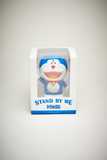Doraemon / Japan
Good feline
As a global Japanese image, Doraemon aptly combines cuteness and faith in technology. But with the blue robot cat from the future seeming increasingly rooted in the past, there’s a sense that Tokyo’s soft-power brokers want to have their ‘dorayaki’ and eat it.

Earlier this year Hong Kong mourned the passing of a man everybody knew but whom few would have recognised. Since 1982, Lam Pou-chuen, who died suddenly at 63, had been the local voice of Doraemon, the blue-and-white cartoon robot cat from the future.
Since first appearing in Japanese children’s comics in the last month of the 1960s, Doraemon has become an Asia-spanning phenomenon, graduating from the pages of manga to television, cinema, video games, ebooks, a musical and an uncountable range of merchandise and advertising hook-ups; it can seem hard to open your eyes in Japan without seeing Doraemon beaming back at you. The official legend attending Doraemon is that he was assembled on 3 September 2112 in the Matsushiba robot factory and moves among us at the request of a 22nd-century boy named Sewashi Nobi, who wants to help out Nobita Nobi – his own infant great-great-grandfather. Nobita is a lazy, hapless and awkward sort who Doraemon attempts to assist with knowledge from the future, producing an arsenal of advanced gadgetry from a portal in his belly that opens to a fourth dimension.
As is generally the case with science-fiction/time-travel set-ups, the logistics do not stand close scrutiny. The more prosaic reality is that Doraemon was created by Fujiko Fujio, a nom de plume employed by the partnership of manga artists Hiroshi Fujimoto and Motoo Abiko. They began working together as teenagers in the early 1950s and their work is now celebrated by a dedicated museum in Kawasaki. Today, Doraemon appears on Japan’s TV Asahi and remains manga’s pre-eminent megastar. In 2013, the attendant movie series sold its 100 millionth ticket in Japan, overtaking Godzilla at the box office.
“For many Japanese,” says Roland Kelts, author of Japanamerica: How Japanese Pop Culture has Invaded the US, “Doraemon was their first encounter with science fiction. But the robot cat from the 22nd century helping save a male slacker by teaching him the importance of diligence and focus was a parable for the future of Japan, if people didn’t work and get educated.” No character endures this long without embodying something beyond itself. It is significant that the period of Doraemon’s greatest surge in popularity, when he made the leap from printed page to television, was approximately the moment that the phrase “Made in Japan” ceased being a punchline and became a guarantor of quality.
“It was that time of Japanese economic growth and maturing into a consumer society,” says Rumi Sakamoto, senior lecturer in Asian studies at the University of Auckland, and co-author of Japanese Popular Culture. “So a story in which science and technology solve kids’ problems and make dreams come true must have fitted the ethos of the era.” The affection harboured by millions of Japanese for Doraemon has inevitably inspired successive Japanese governments to wonder whether he might spark similar fondness for Japan among foreigners. In 2008, Japan’s then foreign minister Masahiko Komura made Doraemon the country’s first “anime ambassador”. At a brief but moving ceremony, Komura presented a Doraemon doll nearly as big as himself with certification of plenipotentiary status and a plate of Doraemon’s preferred dorayaki, or red-bean pancakes. Doraemon also served as a special ambassador on Tokyo’s successful 2020 Olympics bid; it seems safe to assume that the Games’ opening ceremony will feature phalanxes of grinning, weirdly earless animatronic blue felines.
But although syndicated across Asian television networks, Doraemon has not been welcomed universally in the region. In 2014, by way of demonstrating that there is no subject so trivial that China and Japan cannot argue about it, several official Chinese newspapers fulminated against a Doraemon exhibition in Chengdu. “Doraemon is cute,” thundered Global Times columnist Wang Dehua, “but he also represents Japan’s soft power. We must never let a little robotic cat take control of our minds.” Which rather begs the response that where some newspaper commentators were concerned, a little robotic cat couldn’t do a worse job. But it also prompts the question of just what an advanced 21st-century nation thinks it is projecting to the world by enlisting a cartoon character to represent it.
“Visually,” says Sakamoto, “Doraemon embodies the kawaii [cute] culture, with [his] big round head, but not the Kyary Pamyu Pamyu type of over-the-top, girly cute. It’s more acceptable to younger children and their parents. Totally non-threatening. Totally non-problematic. It has a long history, too.”
“You could compare it to the way the US uses Mickey Mouse,” says Kelts. “Doraemon is plucky, spirited, meant to help not hurt. A lot of animated manga is edgy but Doraemon is pretty benign. The problem is that it’s indicative of the Japanese government’s insularity that they assume anyone in the West knows the character.”
Despite Doraemon’s roots in the future, part of his appeal lies in his link to the childhoods of generations of Japanese, and intrusions from the real world are rarely welcome. In 2005, considerable angst attended the departure of Nobuyo Oyama from the anime series, who had voiced Doraemon since 1979. Changes to the character’s appearance have been incremental if even noticeable, and his mastery of technology has been selective: no smartphone has ever been produced from that magic pocket.


